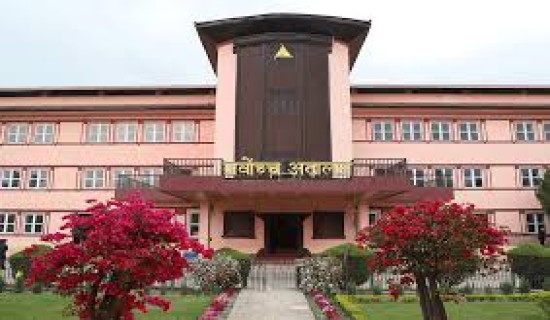- Monday, 29 December 2025
Environmental Challenges And Urban Growth
Nepal, a mountainous country located between China and India along the Hindu Kush Himalayan range, is facing significant environmental challenges. The nation is situated atop a geological deposit that has experienced significant alterations over the past few decades, leading to active land degradation. Key factors contributing to this degradation include the country's topography, changes in land cover due to urbanisation and population growth, and traditional agricultural practices on steep slopes. Soil erodibility from unscientific farming methods, the use of chemical fertilisers, and unsustainable land management practices further exacerbate the issue. Additionally, unscientific infrastructure development and a shift towards non-farm work contribute to these environmental challenges.
Impact of urbanisation
From 1990 to 2020, major cities in Nepal, including Kathmandu, Pokhara, Bharatpur, Hetauda, and Tulsipur, have experienced significant shifts in land use and land cover (LULC). These changes are characterised by a steady increase in built-up areas and a decline in agricultural lands. Kathmandu, in particular, has seen the most substantial urban growth. This urban expansion is largely driven by political changes, the establishment of a federal system, policy shifts, the booming remittance economy, and agricultural abandonment.
Urbanisation without proper planning, regulations, and administration often leads to uncontrolled sprawl. This reduces agricultural lands, decreases ecosystem services, and increases food insecurity and land degradation. The availability of water and green spaces, air quality, climate, flood levels, soil health, and food security are all adversely affected by changes in land use. The expansion of urban areas and deteriorating environmental infrastructure also harm human well-being, especially in poor communities dependent on natural resources.
Environmental degradation
Nepal's inefficient municipal development impacts infrastructure, mobility, and land usage. Inadequate public sector control leads to environmental degradation, declining living standards, and reduced public spaces. The lack of serviced land for public, commercial, and residential use hinders economic growth. Buildings are often constructed near main roads, resulting in ribbon development along highways and peri-urban areas. This sprawl complicates government service provision, hinders community building, and exposes residents to dust, noise, and traffic hazards.
River encroachment is a severe issue in Nepal, with significant consequences. Encroachment disrupts natural water flow, harms the environment, and damages riverine ecosystems, increasing the risk of urban flooding. Pollution from encroached areas lowers water quality, making it unsafe for aquatic life and human consumption. Reduced public access to riverbanks restricts community and recreational activities. Poor urban planning makes communities susceptible to natural disasters like landslides and floods.
For instance, encroachment along the Bagmati River in Kathmandu Valley has resulted in illegitimate buildings impeding the river's flow, raising the risk of urban flooding. Similarly, unapproved building projects and dumps along the Bishnumati River's banks cause significant encroachment problems. Encroachment along the Narayani River in the Chitwan district has led to ecological imbalances and habitat degradation. These instances highlight Nepal's pervasive issue of river encroachment, endangering both public safety and the environment.
Land fragmentation
Another major issue in Nepal is the fragmentation of agricultural land into smaller plots as urban areas expand. This impedes agricultural output and increases sensitivity to environmental hazards such as soil erosion and flooding. It also diminishes biodiversity, intensifies conflicts over land use and ownership, and complicates urban planning initiatives.
Road expansion in Nepal poses significant concerns, particularly regarding socioeconomic issues and pedestrian safety. While roads are widened to accommodate more traffic, pedestrian infrastructure is often neglected, creating dangerous situations for vulnerable populations. Road construction can also displace businesses and informal settlements, worsening socioeconomic disparities and disrupting local lives.
Waste management
Unregulated solid waste disposal on roads, subways, and riverbanks is exacerbating soil degradation and posing major health problems in Nepal. Ineffective waste management techniques lead to the accumulation of plastics, trash, and other pollutants, contaminating soil and water resources. This pollution deteriorates the quality of land and water, putting nearby communities at risk by spreading chemicals and infections. The unsightly presence of waste also hinders initiatives to boost tourism and economic growth.
Strategies
Improving land degradation in Nepal requires a multi-faceted approach integrating sustainable land management practices, policy reforms, and community engagement. Promoting sustainable agriculture, reforestation and afforestation, soil conservation programmes, integrated water management, and climate-resilient practices are essential. Engaging the community and educating the public, conducting research and monitoring, providing economic incentives for farmers, and developing eco-tourism and sustainable livelihoods are also crucial.
Urban growth and agricultural sustainability can be supported by enforcing land-use zoning restrictions, encouraging land consolidation, and supporting agro-forestry programs. These measures can help mitigate the negative effects of land fragmentation. Addressing road expansion concerns requires a comprehensive strategy prioritising equitable urban design, inclusive development techniques, and pedestrian safety.
Youth engagement
Engaging the youth of Nepal in combating land degradation is beneficial due to their energy, creativity, and adaptability. Their involvement can significantly enhance efforts against environmental degradation.
A troubling trend is the neglect of Earth's environmental health amid intense global competition to explore space. Careless waste disposal, pollution, and deforestation harm ecosystems and biodiversity. It is crucial to recognise Earth as our only home and prioritise its preservation through conservation efforts, sustainable practices, and cooperative action to address environmental issues.
Promoting sustainability relies heavily on individuals' actions and dedication to environmental causes. Forming eco-friendly routines and making decisions that minimise negative impacts on the environment are essential. This includes reducing waste, conserving resources, recycling, using energy efficiently, and supporting laws that protect the environment. These actions help preserve biodiversity and natural ecosystems, mitigate climate change, and improve overall quality of life.
To achieve long-term sustainability goals and ensure a healthy planet for future generations, it is imperative to encourage and support the environmental commitment of individuals, communities, corporations, and policymakers. By prioritising the health of our planet, we can guarantee a sustainable future for generations to come.
(The author is a research assistant at the Nepal Academy of Science and Technology, Lalitpur.)
















